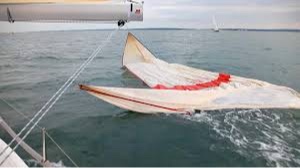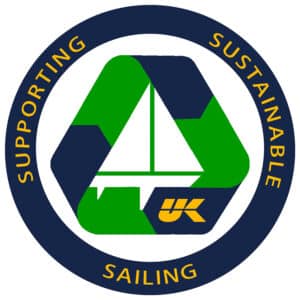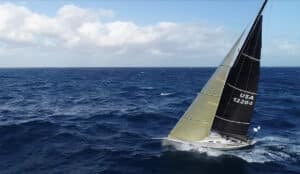Before heading to Australia in December 2017 for their first Sydney-to-Hobart Race, the crew of Andrew Weiss’ CHRISTOPHER DRAGON had a briefing session with renowned ocean racer Richard duMoulin. Rich has over 25 Bermuda Races, a couple of Trans-Atlantic races, a few Fastnets, and at least one Hobart Race in his past…plus breaking the 100+ year-old Tea Route record sailing with Rich Wilson on a trimaran from Hong Kong to New York nonstop. In short, Moulie knows what he’s talking about. With a good deal of the Hobart Race expected to be downwind, duMoulin explained how to recover quickly and safely from the three most common types of spinnaker failures one could encounter at sea. Spoiler Alert: all three recoveries involve being set-up for a letterbox takedown.
A spinnaker in the water has a good chance of ending badly. Yachting World photo.
In the Letter Box take down, the spinnaker is pulled over the boom and under the foot of the mainsail before being stuff through the companion way hatch.
-
If the halyard breaks or halyard shackle opens—The most immediate danger in this scenario is the sail falling into the water in front of the boat with you sailing over it. Immediately the helm should steer closer to the wind to get sail alongside the boat rather than in front and underneath it. If done quickly, the sail will float on top of the water avoiding damage.
The quick crew response is to snug the retrieval line, blow the tack and sheet, and execute a letterbox. Pulling the sail up and over the boom drains the water off the sail making it easier to retrieve. Interestingly, during the Hobart Race, Weiss’ crew encountered this exact situation—the letterbox was pre-set, the sail was retrieved safely, and the same chute was used again later in the race.
-
Tack line breaks or the shackle opens—In this situation the helm bears off quickly to keep the sail in front of the boat while still aloft. If allowed to fly aft on the sheet, it can be difficult to control and ripped easily on the end of the boom. With the bow turned down, snug the retrieval line and do an immediate letterbox takedown.
-
Sheets disconnect or the clew blows out—This is the most difficult of the three because you’ve probably lost the retrieval line attached to the clew. Someone will need to quickly run a new retrieval line to the tack of the spinnaker, bring the new line aft and run that line over the boom, and use that line for your letterbox. The helm must quickly determine which way to steer, especially on a sprit boat, so that someone can safely reach the tack and attach the new retrieval line. This happened in the 2019 Voile de St. Barths on the Marten 49 SUMMER STORM. The tack shackle released unexpectedly and our bowman quickly rigged a take-down line to the tack and we used it to pull the chute down into the companion way. There was no time to get the line through the slot between the boom and the foot of the main.
While this is a post on retrieving problem spinnakers, it’s also a testimonial for always being set-up for a letterbox takedown while sailing offshore. Remember, with the letterbox you can avoid a forward hatch take down which risks getting water down the hatch. And, you don’t have to have anyone on the bow (except for the blown sheet situation). Note: when setting-up for a letterbox for an asym chute, make sure the tack line is long enough that it will allow the sail to be fully retrieved with the tack line still attached. Either that or have in-place a remote trip line for the tack such as a Martin Breaker.
If you’re going offshore to race or do a passage, always have a retrieval line on the clew led over the boom to a snatch block on the windward rail and back to a cockpit winch. By tailing the retriever line on a winch, you prevent the sail getting blown overboard if the crew loses control of the sail. To watch our video on letterbox takedowns, click HERE.




